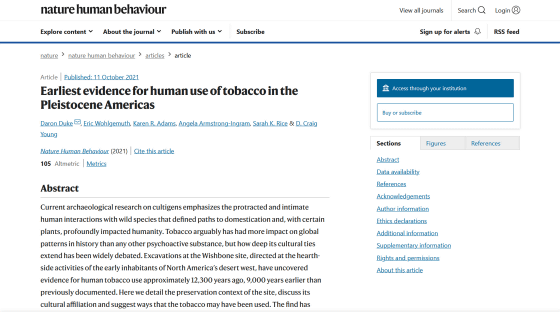The world's oldest evidence that tobacco has been used for about 12,300 years is found

'The oldest evidence that humans used tobacco' was discovered in an indigenous ruin about 12,300 years ago in the desert of Utah, USA. This finding suggests that humans have been using tobacco for thousands of years before previously thought.
Earliest evidence for human use of tobacco in the Pleistocene Americas | Nature Human Behavior

Hearth site in Utah desert reveals human tobacco use 12,300 years ago | Reuters
https://www.reuters.com/lifestyle/science/hearth-site-utah-desert-reveals-human-tobacco-use-12300-years-ago-2021-10-11/
Oldest evidence of humans using tobacco discovered in Utah | Live Science
https://www.livescience.com/earliest-human-tobacco-use-found
To investigate, such as Native American ruins Far Western Anthropological Research Group archaeologist is of Daron Duke and his colleagues of the team lies in the northern Utah Great Salt Lake desert was excavated the ruins of hunter gatherers in the. The site has a fireplace surrounded by crafts such as spearheads, and is called the 'wishbone site' after the duck's wishbone found inside. increase.
The fireplace at Wishbone Site has more than 2000 bones and fragments left, most of which belong to ducks. This suggests that indigenous people cooked in and around the fireplace. The excavation team also reported that they found four carbonized tobacco seeds in the fireplace.
This is the carbonized tobacco seed found by the excavation team. Radiocarbon dating of carbonized willows, also found in fireplaces, believed to have been used for firewood, showed that the willows were about 12,300 years old, so they were indigenous to North America. It was suggested that he had been using tobacco for about 12,300 years.

Some evidence has been found that Native Americans have used tobacco since BC, but a clear indication of nicotine intake was found in a smoking pipe found in Alabama about 3300 years ago. It is said that it is a nicotine residue. This finding suggests that tobacco was used 9000 years earlier than previously thought. 'It was an unexpected surprise to find tobacco seeds,' Duke told the science media Live Science.
Only seeds were found in the fireplace, and it is not possible to determine how the indigenous people actually used tobacco, but the excavation team suggests that the presence of seeds suggests the presence of nicotine-containing leaves and stems. He claims to be doing so, and speculates that the indigenous people may have chewed or smoked tobacco leaves by the fireplace. Regarding the indications that 'duck that ate food just ate tobacco' and 'maybe only used tobacco for sowing', 'birds do not eat tobacco' and 'tobacco produces enough fire for cooking'. It lacks the wood-based materials to be used. '
Native Americans have been using tobacco for ceremonial and medical purposes since BC, and tobacco is said to be the first plant to be cultivated in North America. Duke speculates that tobacco was incorporated into the culture, although there are many uncertainties about the culture that the indigenous people had about 12,300 years ago.
The seed discovered this time is a kind of wild tobacco called Nicotiana attenuata , and it is said that it still grows naturally near the Great Salt Lake Desert. 'This species is not cultivated, but is used by the indigenous peoples of the region to this day,' Duke said. 'People in the past are the ultimate botanists and in tobacco as soon as they reach the Americas. We have identified the value of toxicity. '
The Great Salt Lake Desert at the time of writing the article was dry, but until about 9500 years ago it was a vast wetland. Relics found in the fireplace included sharp stone cutting tools and obsidian spearheads used for hunting large mammals, with one tip containing mammoth or mastodon blood protein. ..

Related Posts:
in Note, Posted by log1h_ik







